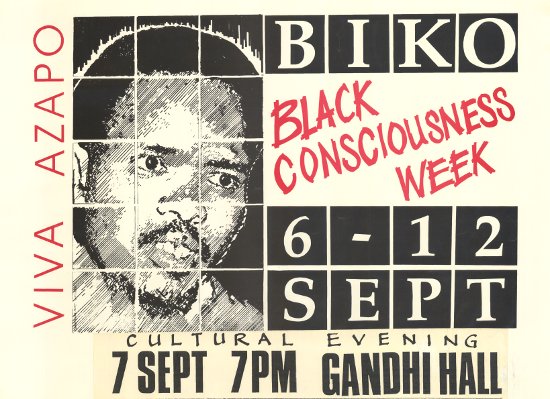"At the heart of black consciousness is the realisation by blacks that the most potent weapon in the hands of the oppressor is the mind of the oppressed."
- Steve Bantu Biko, I Write What I Like, 1978.
In terms of the struggle against apartheid, the 1960s in South Africa is often referred to as the ‘Silent Sixties’. With the banning of the ANC and the Pan African Congress (PAC) and the imprisonment of the leadership on Robben Island after the Sharpeville massacre, very little resistance took place. It was left up to a new generation of young students to take the lead in the 1970s in the Black Consciousness Movement.
In the 1960s white young progressive students on liberal university campuses had formed the National Union of South African Students (NUSAS), an organisation that opposed apartheid. Black university students also joined NUSAS but were becoming increasingly uneasy and angry that white students held the leadership positions in NUSAS. They believed that a white-dominated organisation was not able to look after the interests of black students. In 1969, black students broke away from NUSAS and formed their own student organisation known as the South African Students Organisation (SASO). Its leader was a young, dynamic medical student by the name of Steve Biko.
 Biko and his young comrades promoted the philosophy of Black Consciousness, which urged black people to free themselves from the chains of oppression and for all blacks (including Africans, Coloureds and Indians) to work towards liberation. Biko urged black people to take responsibility for their own struggle and not to rely on white liberals. To do this, it was necessary for black people to free themselves from the feelings of inferiority that had been instilled in them after 300 years of oppression. Rather, black people were to develop a pride in being black, and develop the self-confidence to determine their own future.
Biko and his young comrades promoted the philosophy of Black Consciousness, which urged black people to free themselves from the chains of oppression and for all blacks (including Africans, Coloureds and Indians) to work towards liberation. Biko urged black people to take responsibility for their own struggle and not to rely on white liberals. To do this, it was necessary for black people to free themselves from the feelings of inferiority that had been instilled in them after 300 years of oppression. Rather, black people were to develop a pride in being black, and develop the self-confidence to determine their own future.
The Black Consciousness Movement (BCM) challenged the entire white structure that existed in South Africa by developing alternative structures. The students established the Black People’s Convention (BPC), which was an umbrella organisation to coordinate all Black Consciousness activities. It encouraged self-reliance through the creation of Black Community Programmes.
Black Consciousness played an important role in inspiring the Soweto youth to action in 1976. Its philosophy filled them with the self-confidence to address their own harsh circumstances. The South African Students’ Movement (SASM) was a Black Consciousness organisation of high school students, formed in 1968. SASM was central in politicising school students and encouraging them to take action. In 1973, a number of SASO students staged a walkout from black universities. Many of them became teachers in Soweto schools and also inspired the students to action.
Exhibitions in the classroom
Analyse the philosophy of Black Consciousness
SOURCE: Steve Bantu Biko. “I Write What I Like” 1978.
Read the quotations by Steve Biko that are on this panel and then answer the following questions:
- What do you think Steve Biko meant in the quote above.
- In the second quotation,
“The first step therefore is to make the black man come to himself; to pump back life into his empty shell; to infuse him with pride and dignity, to remind him of his complicity in the crime of allowing himself to be misused and therefore letting evil reign supreme in the country of his birth.”
Biko talks of black people being ‘complicit’ in their own oppression. What did he mean by this? Provide some examples from the apartheid era where black people might have been ‘complicit’ in their own oppression.
3. What does Biko see as the similarities and differences between black and white people in the 1970s in South Africa?
NEXT: The youth take charge: the Soweto Uprising of June 16


